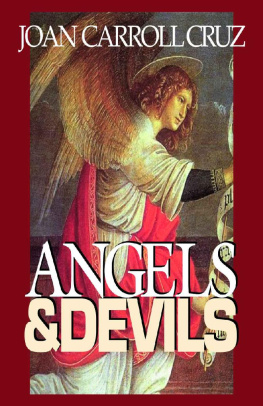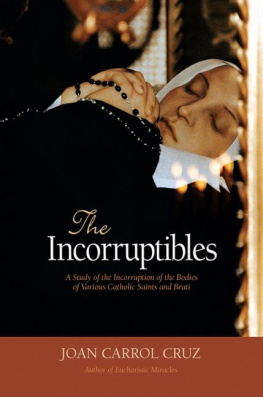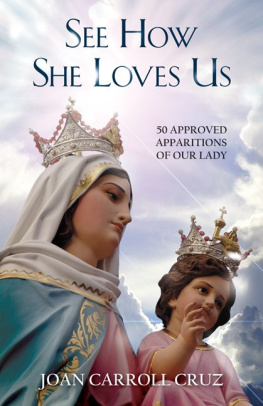Joan Carroll Cruz - Miraculous Images of Our Lady
Here you can read online Joan Carroll Cruz - Miraculous Images of Our Lady full text of the book (entire story) in english for free. Download pdf and epub, get meaning, cover and reviews about this ebook. year: 2009, publisher: TAN Books, genre: Religion. Description of the work, (preface) as well as reviews are available. Best literature library LitArk.com created for fans of good reading and offers a wide selection of genres:
Romance novel
Science fiction
Adventure
Detective
Science
History
Home and family
Prose
Art
Politics
Computer
Non-fiction
Religion
Business
Children
Humor
Choose a favorite category and find really read worthwhile books. Enjoy immersion in the world of imagination, feel the emotions of the characters or learn something new for yourself, make an fascinating discovery.

- Book:Miraculous Images of Our Lady
- Author:
- Publisher:TAN Books
- Genre:
- Year:2009
- Rating:4 / 5
- Favourites:Add to favourites
- Your mark:
- 80
- 1
- 2
- 3
- 4
- 5
Miraculous Images of Our Lady: summary, description and annotation
We offer to read an annotation, description, summary or preface (depends on what the author of the book "Miraculous Images of Our Lady" wrote himself). If you haven't found the necessary information about the book — write in the comments, we will try to find it.
Miraculous Images of Our Lady — read online for free the complete book (whole text) full work
Below is the text of the book, divided by pages. System saving the place of the last page read, allows you to conveniently read the book "Miraculous Images of Our Lady" online for free, without having to search again every time where you left off. Put a bookmark, and you can go to the page where you finished reading at any time.
Font size:
Interval:
Bookmark:

Our Lady of Confidence
A 17th-century Italian portrait by Carlo Maratta.

Other Books by the Author
Secular Saints
Prayers and Heavenly Promises
The Incorruptibles
Eucharistic Miracles
Relics
The Desires of Thy Heart
| Nihil Obstat: | Father Terence J. Tekippe Censor Librorum | |
| Imprimatur: |  | Most Rev. Francis B. Schulte Archbishop of New Orleans May 22, 1992 |
The Nihil Obstat and Imprimatur are the Churchs declarations that a work is free from error in matters of faith and morals. It in no way implies that the Church endorses the contents of the work.
Copyright 1993 by Joan Carroll Cruz.
All rights reserved. No part of this book may be reproduced or transmitted in any form or by any means, electronic or mechanical, including photocopying, recording, or by any information storage or retrieval system, without permission in writing from the Publisher.
Cover Picture: Our Lady of the Holy Rosary . (See .)
Library of Congress Catalog Card No.: 92 62149
ISBN: 978-0-89555-484-0
Printed and bound in the United States of America.
TAN Books
An Imprint of Saint Benedict Press, LLC
Charlotte, North Carolina
2012
There is not a church without an altar in her honor, not a country nor a canton where there are not some miraculous images where all sorts of evils are cured and all sorts of good gifts obtained.
St. Louis Marie De Montfort
True Devotion to Mary
C ONTENTS
ARGENTINA
AUSTRIA
BELGIUM
BOLIVIA
CANADA
CUBA
ECUADOR
FRANCE
GERMANY
HUNGARY
IRELAND
ITALY
JAPAN
LITHUANIA
LUXEMBOURG
MADEIRA
MALTA
MEXICO
THE NETHERLANDS
THE PHILIPPINES
POLAND
PORTUGAL
SPAIN
SWITZERLAND
UNITED STATES OF AMERICA
I NTRODUCTION
Catholics do not adore statues or other representations of Our Lord, His Mother or the Saints, nor do we pray to these images. In early childhood, we are taught from our Catechism that we do not pray to the crucifix or to the images of Christ and of the Saints, but to the persons of whom they remind us. Because they represent holy persons, images are treated with becoming reverence, even as the picture of ones mother would be.
This subject was clarified by the Council of Trent during its 25th session in December 1563:
Moreover, [the faithful must be instructed] that the images of Christ, of the Virgin Mother of God, and of the other Saints are to be placed and retained especially in the churches, and that due honor and veneration is to be given them because the honor which is shown them is referred to the prototypes which they represent, so that by means of the images which we kiss and before which we uncover the head and prostrate ourselves, we adore Christ and venerate the Saints whose likeness they bear. That is what was defined by the decrees of the Councils, especially of the Second Council of Nicaea (787 A.D.) against the opponents of images.
From the earliest days of the Church, images were painted on the walls of the catacombs as religious expressions of the faithful, as acts of veneration and as aids in visualizing Our Lord, His miracles and His Holy Mother. We are told by St. John of the Cross in Book III, of The Ascent of Mount Carmel : The Church established the use of statues (and images) for two principal reasons: the reverence given to the Saints through them and the motivation of the will and the awakening of devotion to the Saints by their means. Insofar as they serve this purpose their use is profitable and necessary. The Saint also tells us, Since images serve as a motivating means toward invisible things, we should strive that the motivation, affection, and joy of will derived from them be directed toward the living object they represent.
Without question, the most popular image of a Saint found in churches throughout the world is that of the Queen of Saints, the Blessed Virgin Mary. One would be hard pressed to find a church, chapel or oratory that does not contain an image of the Mother of God.
Of these images of our Holy Mother, some have been identified as being miraculous. It is not that the statue or painting is miraculous of itself, but it does seem that Our Lady favors certain of her replicas and often honors the requests of those persons who visit them to express their needs and their love for her.
The purpose of this work is to identify 100 of these favored images and to chart their histories and the reasons for their designation as miraculous objects. It must be understood that the Blessed Virgin does not perform the miracles by herself. It is ultimately our Heavenly Father who performs the miracles according to His holy will at the request of Our Lady. For this reason, the Virgin Mary is known as the Mediatrix of All Graces who pleads our cause before Gods holy throne.
For an image to be included in this collection, the painting or statue must fit into one or more of the following categories:
- It must have had a miraculous origin, such as the image of Our Lady of Guadalupe.
- It must be composed of an unusual substance, such as the portrait of Absam, Austria.
- It must have bled, wept, exuded manna, or changed location, such as the portrait of Our Lady of Good Counsel.
- Something unusual must have happened to it, such as that which affected the statue of Our Lady of the Thunderbolt.
- It must have a reputation for miraculous cures and favors.
Many of the 100 images included in this volume fall into two or more of these categories.
It must be noted that all the images mentioned in this volume were thoroughly studied by Church authorities before ecclesiastical permission was granted for the images to be enshrined and honored in their respective churches or shrines.
The sanctuaries that house these miraculous images were especially selected by Our Lady. In keeping with her humble life at Nazareth, Our Lady chose places that were beautiful in their quiet simplicity. In almost every instance, the corner chosen was retiring and withdrawn from the world. A few of these shrines have maintained their reverent isolation, but in many instances a chapel located outside a village eventually became embraced by the houses and businesses of an expanding population. For this reason, some shrines are now surrounded by great cities. To accommodate the growing numbers of Our Ladys devotees, many of the simple chapels that were first erected to house her images developed into churches and finally into magnificent basilicas.
As Henry Martin Gillett noted in his Famous Shrines of Our Lady , Once Our Lady has been given a shrine, it may be said that the site belongs to her for all time. For one reason or another her subjects may forget their allegiance and even blot out every trace of the original sanctuary; but the site remains hers. And sooner or later she comes back to her own. Sometimes people are moved to restore the old. At other times her more faithful children, quite ignorant of past history, are inspired to establish a new shrine quite near the old foundations. The reader will find that such has happened repeatedly, due to marvelous and unusual promptings.
Although many of the miraculous images of Our Lady are exquisitely beautiful, the reader will discover that some of them are regarded as miraculous even though they are of poor workmanship. Many have been damaged by time, while some are downright unflattering representations of our beautiful Madonna. St. John of the Cross, in Book III, Chapter 36 of his Ascent of Mount Carmel , explains, Experience even teaches that if God grants some favors and works miracles, He does so through some statues that are not very well carved or carefully painted, or that are poor representations, so that the faithful will not attribute any of these wonders to the statue or painting. St. John of the Cross has dedicated Chapters 35, 36 and 37 of his Ascent of Mount Carmel to the subject of miraculous images, the benefits to be derived through their veneration and valuable precautions to be observed. The reader is encouraged to study these chapters, which are written by a Doctor of the Church who is also acknowledged as a master of the spiritual life.
Next pageFont size:
Interval:
Bookmark:
Similar books «Miraculous Images of Our Lady»
Look at similar books to Miraculous Images of Our Lady. We have selected literature similar in name and meaning in the hope of providing readers with more options to find new, interesting, not yet read works.
Discussion, reviews of the book Miraculous Images of Our Lady and just readers' own opinions. Leave your comments, write what you think about the work, its meaning or the main characters. Specify what exactly you liked and what you didn't like, and why you think so.




